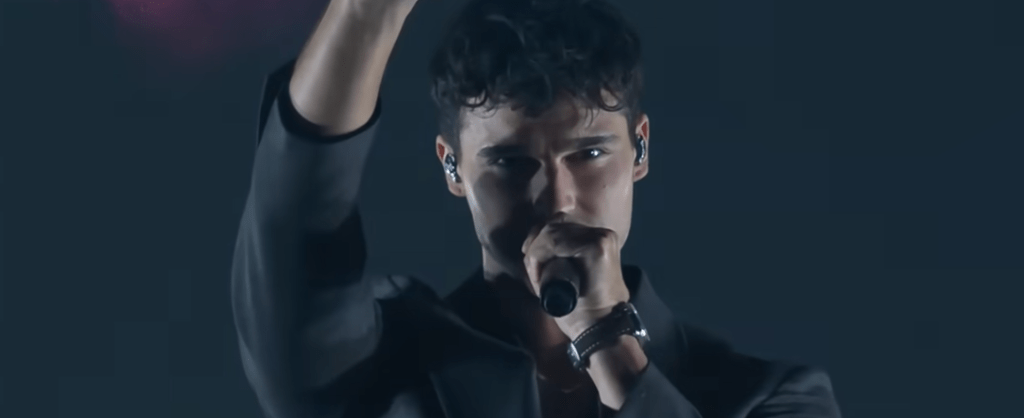Eric Saade Net Worth – Bio and Financial Overview
| Category | Information |
|---|---|
| Full Name | Eric Khaled Saade |
| Birthdate | October 29, 1990 |
| Nationality | Swedish (Lebanese-Palestinian heritage) |
| Profession | Singer, Songwriter, TV Presenter, Model |
| Career Start | 2005 (with boy band What’s Up!) |
| Major Breakthrough | Eurovision 2011 – Third Place with “Popular” |
| Record Labels | Roxy Recordings, Warner Music Sweden |
| Estimated Net Worth | Approx. $83.8K to $1.3M+ (varied sources, including Popnable & SPEAKRJ) |
| YouTube Channel | “Eric Saade – Topic” (Daily Income: $2–$44; Monthly: $59–$1.3K) |
| Reference Link | Wikipedia – Eric Saade |
A silent revolution in contemporary pop entrepreneurship can be found in Eric Saade’s financial journey. He established a brand that is remarkably resilient and deeply personal. He was born in 1990 and raised in Sweden with strong Lebanese-Palestinian roots. According to various sources, his current net worth ranges from $83,800 to $1.3 million, which includes both music sales and a varied and remarkably successful media strategy.
In the middle of the 2000s, Saade started his ascent with the boy band “What’s Up!” but his path was altered by Eurovision 2011. With his third-place finish on “Popular,” he won over hearts throughout Europe and opened doors outside of Sweden. Platinum certifications, sold-out stadiums, and brand appeal that went well beyond chart positions were the results of that momentum. Instead of fading, he retooled and became a multimedia artist with remarkable adaptability.
Saade’s earnings structure has changed significantly over the last ten years. Under the “Eric Saade – Topic” banner, his YouTube presence generates a modest monthly income of between $59 and $1.3K. However, that platform is only a single component of a bigger picture. What’s especially advantageous is the way he blended music and business. Saade entered the fashion and brand partnerships market by working with influencer and businesswoman Hanna Schönberg, which increased his visibility and generated steady revenue.
According to reports, the two co-manage businesses worth more than 325 million Swedish kronor. These are carefully planned campaigns that combine lifestyle aesthetics with a fan base that is hungry for authenticity; they are not vanity projects. Because of his polished yet personable image, Eric Saade is very appealing for cross-platform marketing and sponsorships, particularly in the Nordic and German-speaking markets.
His staging decisions are always creative during performances. He makes extensive use of intricate choreography, emotionally charged vocals, and narratively driven imagery. His entries at Melodifestivalen kept changing, indicating maturity instead of duplication. That development is not only artistic; it is also calculated from a financial standpoint. Saade has greatly lessened his reliance on quick hits by remaining relevant to both younger and older audiences.
Saade stirred up controversy in recent months when he wore a traditional symbol of his Palestinian heritage, the keffiyeh, on the stage during the Eurovision semi-final. Although the gesture was criticized by the European Broadcasting Union for violating political neutrality, it was a potent point of connection for fans. Saade strengthened his identity-driven appeal by disclosing his origins on such a prominent platform. Even though that decision wasn’t made with a profit in mind, it increased his cultural capital, which frequently results in greater brand loyalty.
With millions of monthly listeners, his performance on Spotify is still strong. Even though his streaming revenue varies, his live performance value, merchandise sales, and licensing opportunities are all boosted by this visibility. Working with seasoned partners rather than overburdened management teams, Saade also benefits from a comparatively lean organizational structure. This has turned out to be a very effective way to plan tours, handle releases, and create video content with little waste.
Trial, flexibility, and a distinct sense of personal branding have all been key components of the journey from teenage heartthrob to well-respected solo performer. Bubblegum pop has gradually given way to darker, more reflective music in his repertoire. That shift reflected the maturity of his audience. Fans in their 30s who first heard “Popular” in their teens are still interested and listening. His brand is reviving thanks to this aging audience and new followers attracted to visual storytelling and identity exploration.
Saade’s financial structure is not reliant on a single, significant hit. Rather, it survives by consistently achieving moderate success. Even though his albums don’t reach the top of the Billboard charts, they do remarkably well in Scandinavia. A layered and noticeably better income structure is created by merchandise associated with his tours, fashion partnerships with Schönberg, and sporadic TV appearances.
Saade’s ability to combine art and brand consistency is what makes them remarkably similar to other internationally renowned acts like Troye Sivan or Måns Zelmerlöw. Here, there is only consistent growth driven by authenticity rather than reinvention for shock value. Saade seems to make well-informed decisions, especially when it comes to long-term positioning as opposed to immediate virality.
Eric Saade is a very adaptable example for creatives attempting to strike a balance between sustainability and relevance. His career has developed like a well-balanced piece of music, with each chorus grounded in personal truth and each beat purposeful. For him, achieving financial stability took time. Layer by layer, decision by decision, frequently in silence, but always with accuracy, it was constructed.

